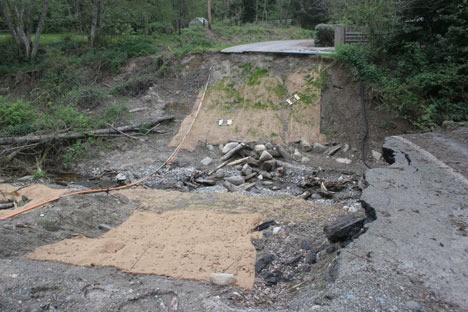Maybe the best thing to do with washed-out Glendale Road is to leave it washed out, Island County Engineer Randy Brackett said Monday.
“We’re not hearing much in the way of support for reconnection,” Brackett said as he prepared for the last in a series of well-attended community meetings in the wake of last spring’s Glendale Creek flood.
The final seminar will be 6:30 to 8:30 p.m. Thursday, April 15, at Clinton Community Hall, 6411 Central Ave.
“We’re hearing a lot of people expressing that a higher value be given to the stream, as opposed to transportation,” Brackett said.
“It’s not unanimous, but there’s a pretty strong consensus. Of course, we haven’t heard from everybody,” he added.
Brackett said that before the flood, only 200 vehicles a day or so traveled the short section of road connecting Holst Road and roads leading to Cultus Bay Road.
“That’s a pretty low volume,” he said, adding that residents in the area also are concerned with traffic noise.
Officials say the county incurred the loss of $2 million worth of roadway in the flood, and spent another $60,000 in assisting Glendale residents with the cleanup.
As for road repair, officials list three options.
These include creating turnarounds on either side of the gap, installing a large-diameter oblong arch culvert under a repaired roadway or building a bridge across the divide.
A culvert and repaired roadway, or a bridge, would probably cost more than $1.3 million, officials say. The total package for either option, including stream restoration, has been estimated at more than $3 million and would require at least two to three years to complete.
The county is pursuing state and federal funds to help pay for repairs, Brackett said.
Most residents so far have said that repairing the stream and rehabilitating salmon spawning should be a higher priority than repairing the road, Brackett said.
“We’ve learned a lot that will help us in going forward with our recommendations,” he said.
The collapse of a portion of a beaver dam was blamed for triggering the early April 2009 flood that forced Glendale residents from their homes and did more than $5 million in damage.
Rising water in the creek wiped out a 20-foot-deep section of Glendale Road about 100 feet wide just off Holst Road. The flood also washed out the culvert under the road, and sent a wall of water, mud and debris rushing a mile down the canyon into the Glendale beach community.
Eight homes, the Glendale Hotel and the old Ford Garage were damaged. Residents had been evacuated hours earlier, and there were no reported injuries.
The recent series of meetings conducted by the county, in association with WSU Island County Extension and Whidbey Watershed Stewards, was designed to explore the geological, natural and human interactions with the creek, and to collect as much community sentiment as possible.
Thursday’s session will feature county staff and Jamie Bailes and Doug Thompson of the Washington Department of Fish and Wildlife, who will discuss funding, regulations and future plans for the area.
A river hydrologist also will discuss water levels and flows as they relate to beaver dams, Brackett said.
For more information, call Brackett at 321-5111, ext. 7954, or e-mail RandyB@co.island.wa.us.
Presentations and audio recordings of previous speakers in the series “Story of a Stream” are posted on Island County’s Web site, http://islandcounty.net/publicworks/Glendale.



